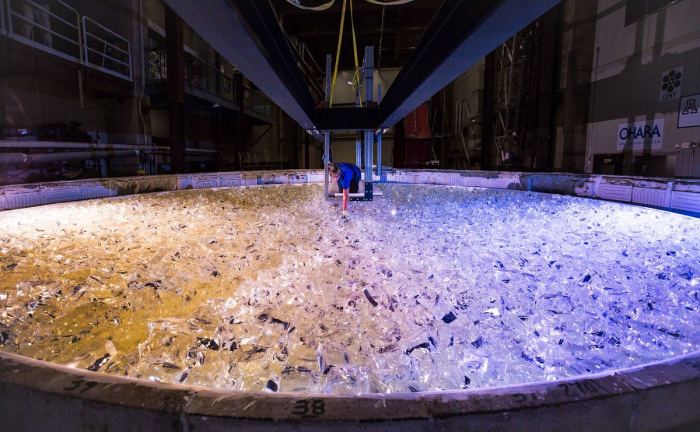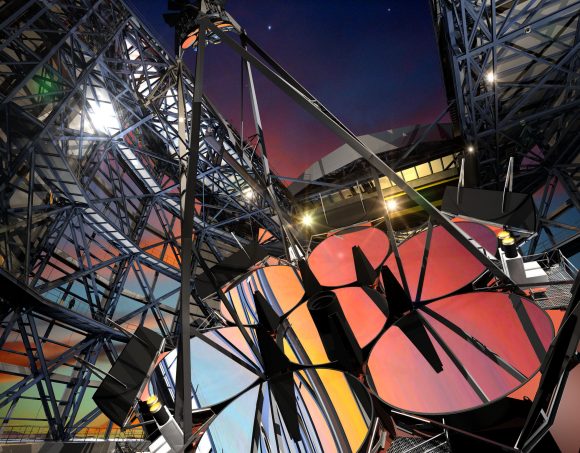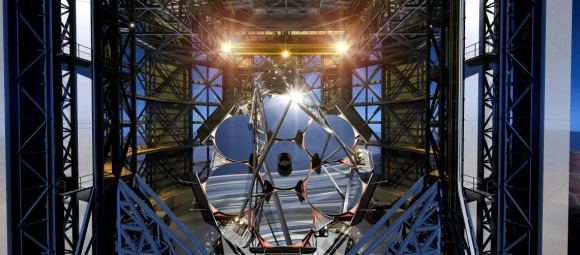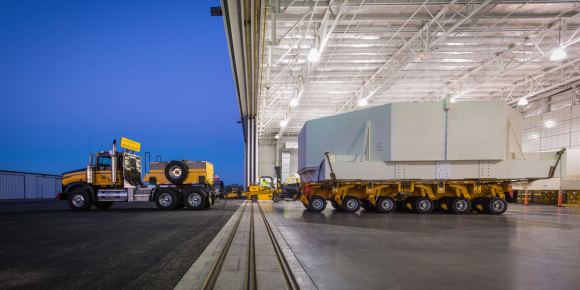Skip to comments.
They Just Began Casting the Giant Magellan Telescope’s 5th Mirror. What a Monster Job.
Universe Today ^
| 11/7/17
| Evan Gough
Posted on 11/08/2017 8:10:47 PM PST by LibWhacker

The fifth mirror for the GMT's 7 segment primary mirror is being cast at the Richard F. Caris Mirror Laboratory at the University of Arizona. In this image, a worker at the lab places the last piece of glass for mirror 5. Image: Giant Magellan Telescope Organization
They Just Began Casting the Giant Magellan Telescope’s 5th Mirror. What a Monster Job.
The fifth mirror for the Giant Magellan Telescope (GMT) is now being cast, according to an announcement from the Giant Magellan Telescope Organization (GMTO), the body behind the project. The GMT is a ground-breaking segmented telescope consisting of 7 gigantic mirrors, and is being built at the Las Campanas Observatory, in Atacama, Chile.
The mirrors for the GMT are being cast at the Richard F. Caris Mirror Laboratory, at the University of Arizona. This lab is the world centre when it comes to building large mirrors for telescopes. But in a lab known for ground-breaking, precision manufacturing, the GMT’s mirrors are pushing the engineering to its limits.

This illustration shows what the Giant Magellan Telescope will look like when it comes online. The fifth of its seven mirror segments is being cast now. Each of the segments is a 20 ton piece of glass. Image: Giant Magellan Telescope – GMTO Corporation
Seven separate mirrors, each the same size (8.4 meters,) will make up the GMT’s primary mirror. One mirror will be in the centre, and six will be arranged in a circle around it. Each one of these mirrors is a 20 ton glass behemoth, and each one is cast separately. Once the seven are manufactured (and one extra, just in case) they will be assembled at the observatory site.
The result will be an optical, light-gathering surface almost 24.5 meters (80 ft.) in diameter. That is an enormous telescope, and it’s taking extremely precise engineering and manufacturing to build these mirrors.
The glass for the mirrors is custom-manufactured, low-expansion glass from Japan. This glass comes as blocks, and each mirror requires exactly 17,481 kg of these glass blocks. A custom built furnace and mold heats the glass to 1165°C (2129°F) for several hours. The glass liquefies and flows into the mold. During this time, the mold is rotated at up to 5 rpm. Then the rotation is slowed, and for several months the glass cools in the mold.
After lengthy cooling, the glass can be polished. The tolerances for the mirrors, and the final shape they must take, requires very careful, extremely accurate polishing. The first mirror was cast in 2005, and in 2011 it was still being polished.
The mirrors for the GMT are not flat; they’re described as “potato chips.” They’re aspherical and parabaloidal. They have to be surface polished to an accuracy of 25 nanometers, which is a fraction of the wavelength of light.

Precision manufacturing is at the heart of the Giant Magellan Telescope. The surface of each mirror must be polished to within a fraction of the wavelength of light. Image: Giant Magellan Telescope Organization
“Casting the mirrors for the Giant Magellan Telescope is a huge undertaking, and we are very proud of the UA’s leading role creating this new resource for scientific discovery. The GMT partnership and Caris Mirror Lab are outstanding examples of how we can tackle complex challenges with innovative solutions,” said UA President Robert C. Robbins. “The University of Arizona has such an amazing tradition of excellence in space exploration, and I have been constantly impressed by the things our faculty, staff, and students in astronomy and space sciences can accomplish.”
Mirror construction for the GMT is a multi-stage process. The first mirror was completed several years ago and is in storage. Three others are in various stages of grinding and polishing. The glass for mirror 6 is in storage awaiting casting, and the glass for mirror 7 is on order from Japan.
Once completed, the GMT will be situated in Atacama, at the Las Campanas Observatory, where high-elevation and clear skies make for excellent seeing conditions. First light is planned for the mid 2020’s.

When the mirrors for the GMT are completed, they are transported in a special container with shock absorbers and insulation. In this image, the first completed mirror is moved from the Caris Mirror Lab to storage several miles away. Image: GMTO Corp.
The GMT will be largest telescope in existence, at least until the Thirty Meter Telescope and the European Extremely Large Telescope supersede it.
“Creating the largest telescope in history is a monumental endeavor, and the GMT will be among the largest privately-funded scientific initiatives to date,” said Taft Armandroff, Professor of Astronomy and Director of the McDonald Observatory at The University of Texas at Austin, and Vice-Chair of the GMTO Corporation Board of Directors. “With this next milestone, and with the leadership, technical, financial and scientific prowess of the members of the GMTO partnership, we continue on the path to the completion of this great observatory.”
The power of the GMT will allow it to directly image extra-solar planets. That alone is enough to get anyone excited. But the GMT will also study things like the formation of stars, planets, and disks; the assembly and evolution of galaxies; fundamental physics; and first light and re-ionization.
The Giant Magellan Telescope is one of the world’s Super Telescopes that we covered in this series of articles. The Super Telescopes include the:
- Giant Magellan Telescope
- James Webb Space Telescope
- Thirty Meter Telescope
- European Extremely Large Telescope
- Large Synoptic Survey Telescope
- Wide Field Infrared Survey Telescope
You can also watch our videos on the Super Telescopes: Part 1: Ground Telescopes, and Part 2: Space Telescopes.
TOPICS: Astronomy; Science
KEYWORDS: casting; megellan; mirror; telescope
Navigation: use the links below to view more comments.
first previous 1-20, 21-40, 41-42 next last
To: LibWhacker
This sucker won’t even start to come online until 2023.
21
posted on
11/08/2017 10:27:18 PM PST
by
lefty-lie-spy
(Stay metal. For the Horde \m/("_")\m/ - via iPhone from Tokyo.)
To: zeestephen
Any imaging success you get from CCD’s will only be improved by focusing incoming light using large mirrors. It makes sense to use both, which is what modern telescopes generally do.
To: crz
We looked into making our own 8” mirror so the kids could see Halley’s Comet back in 1986. The basic grinding process was simple. As you got closer to the final surface shape, you had to wet the surface to make it reflective, then look at a sheet of graph paper placed several feet away.
Any mirror distortion was evident in the reflected image.
Once the reflected image was correct, you had to send the mirror off to have it coated.
We ended up buying an 8” silvered mirror and constricting the rest of the telescope.
http://www.scopemaking.net/mirror/mirror.htm
23
posted on
11/09/2017 1:09:02 AM PST
by
BwanaNdege
("The church ... is not the master or the servant of the state, but the conscience" - Luther)
To: LibWhacker
24
posted on
11/09/2017 1:23:57 AM PST
by
4Liberty
(MSM = Democrat' PR firm. Mainstream "news" = Fiat news.)
To: zeestephen
As a physics Ph. D., I’m going to venture to say “No”, as to the general idea, because CCD’s don’t preserve phase information the way mirrors and lenses do.
“Let us now praise optics”
25
posted on
11/09/2017 3:05:59 AM PST
by
dr_lew
(I)
To: BwanaNdege
My best friend was part owner of a ship repair company with 4 other guys, one of them was into telescopes. They would grind their mirror, not sure of the size, at their meetings pushing and pulling back and forth. Took them awhile.
They used a sonotube?, one of those molds for pouring concrete pilings, as the body and built a Dobsonian? telescope that was very large. You had to stand on a stepladder to see into this thing.
I’ll never forget seeing the Orion Nebula through it. It looked just like the pictures in astronomy class I was taking at the time. I was amazed at the quality of the images, especally as it was a DIY project.
26
posted on
11/09/2017 3:38:20 AM PST
by
Comment Not Approved
(When bureaucrats outlaw hunting, outlaws will hunt bureaucrats.)
To: Telepathic Intruder
The CCD’s are chilled to reduce thermal noise. A computer is used to integrate the image - it gets to the point of counting individual photons hitting each pixel.
27
posted on
11/09/2017 6:52:02 AM PST
by
Fred Hayek
(The Democratic Party is now the operational arm of the CPUSA)
To: crz; Chode; Squantos; All
VERY, VERY CAREFULLY with Fine Polish Compound and LOTS of furry Bunny 🐰 wabbits. You hold them by the feet, dip their back into the Compound just a bit and Start Polishing.
28
posted on
11/09/2017 9:45:35 AM PST
by
mabarker1
(Progress- the opposite of congress)
To: LibWhacker
29
posted on
11/09/2017 9:47:43 AM PST
by
mabarker1
(Progress- the opposite of congress)
To: Comment Not Approved
Well, you’ve got me motivated now. I’ll have to consider building a telescope with the grandkids.
This time we’ll grind our own mirror! Last time we were in Kenya & the hassles shipping a DIY mirror out to be silvered mandated a ‘store-bought’ mirror.
Sonotubes are a great idea for the larger sizes, perhaps wrapped in a layer of fiberglass cloth & resin to make it water-proof. We used 8” aluminum irrigation pipe, IIRC.
30
posted on
11/09/2017 10:20:39 AM PST
by
BwanaNdege
("The church ... is not the master or the servant of the state, but the conscience" - Luther)
To: dr_lew
Thanks, Doc.
I have always had great difficulty in understanding light, specifically, the particle-wave duality and the multitude of energy levels.
By “phase information” I presume you mean something like infrared, visible, ultraviolet, etc.
My original thought on this subject was, “Why not cover acres of ground with CCDs instead of spending 20 years casting and grinding mirrors?”
I had always assumed the issue was computer processing power for trillions and trillions of pixels.
To: LibWhacker
960 inches or 24,384mm for the entire telescope.
24,384mm / 25mm = 975x magnification.
I guess we still won’t be seeing Martians.
Calculating Magnification
The magnification is the telescope focal length divided by the eyepiece focal length, in millimeters.
Magnification = Telescope focal length ÷ Eyepiece focal length
For example, if you use a telescope of 1000mm focal length with a 25mm eyepiece, the magnification would be 40x (1000mm ÷ 25 = 40). Doubling the power gives you one-fourth the image brightness and reduces the sharpness by one half.
https://www.telescope.com/Telescope-Power-Magnification/p/99813.uts
To: Fred Hayek; zeestephen
But as always, the more photons the better when it comes to imaging dim objects farther out in space than anyone has yet seen. And for that you need more surface area, which means larger mirrors. CCD’s are the modern equivalent of photographic film; they just count photons, and need something to focus them first to form a meaningful picture.
To: mabarker1

oh YEAH?

34
posted on
11/09/2017 3:32:26 PM PST
by
Chode
(You have all of the resources you are going to have. Abandon your illusions and plan accordingly.)
To: Telepathic Intruder
Re: “CCD’s are the modern equivalent of photographic film; they just count photons, and need something to focus them first to form a meaningful picture.”
Thanks - that's helpful.
Is it possible to mass produce an inexpensive lens for CCDs?
To: zeestephen
If I knew how to make lenses cheaper, I would patent it before telling you. But I don’t think lenses themselves have changed in the last few hundred years.
To: zeestephen
By “phase information” I presume you mean something like infrared, visible, ultraviolet, etc.That's not it. "Phase information" charactises "coherence", as a laser, for example, is a coherent beam of light. This is what allows it to produce interference patterns.
You can shine a laser through a lens, and bounce it off mirrors, and this coherence will be preserved, but CCD's require absorption of photons, and so the information thus recorded is reduced to INTENSITY, as opposed to AMPLITUDE, which preserves or carries "phase information". So a surface of CCDs can never duplicate an optical mirror surface.
This is according to my own understanding, and I stand ready to be corrected, ( but it would take some doing! )
37
posted on
11/10/2017 9:12:17 PM PST
by
dr_lew
(I)
To: dr_lew
Thanks. That's helpful.
An earlier Comment said that a CCD was like the raw film in a camera - it just “counts” the photons.
It requires a lens to create a photograph.
So, tomorrow, I will be at You Tube watching educational videos about phase information, interference patterns, and amplitude.
To: brytlea; cripplecreek; decimon; disndat; KoRn; Grammy; steelyourfaith; Mmogamer; dayglored; ...
Thanks LibWhacker. Ping to APoD members.
39
posted on
11/11/2017 1:00:35 PM PST
by
SunkenCiv
(www.tapatalk.com/groups/godsgravesglyphs/, forum.darwincentral.org, www.gopbriefingroom.com)
To: Comment Not Approved
“Dobsonian” -
That is a type of mount for a Newtonian. It was designed by John Dobson, well known amateur astronomer. I met him once at The Orange Blossom Special starparty in Florida. He was interesting, but, a bit of a mooch.
I’ve been using a scope for 45+ years now, and, have never seen any value in grinding my own mirror, when there are so many folks out there that make good ones relatively cheap. It takes all kinds though.
Now building a scope around a mirror is another thing all together. My current scope was hand made by a late member of our club. It’s a fine machine all together, but, the mirrors were bought, not, ground by hand.
All that said, the most important thing is once you get it ready, to go out and use it. Even in the suburbs there are things in the sky to see.
40
posted on
11/11/2017 5:10:11 PM PST
by
Conan the Librarian
(The Best in Life is to crush my enemies, see them driven before me, and the Dewey Decimal System)
Navigation: use the links below to view more comments.
first previous 1-20, 21-40, 41-42 next last
Disclaimer:
Opinions posted on Free Republic are those of the individual
posters and do not necessarily represent the opinion of Free Republic or its
management. All materials posted herein are protected by copyright law and the
exemption for fair use of copyrighted works.
FreeRepublic.com is powered by software copyright 2000-2008 John Robinson




 oh YEAH?
oh YEAH? 